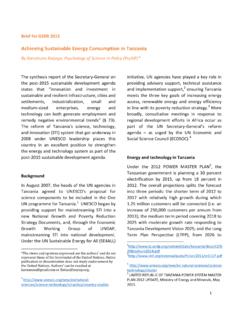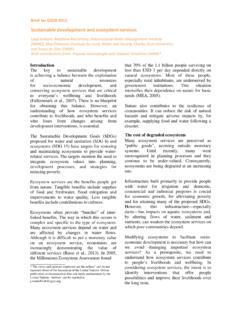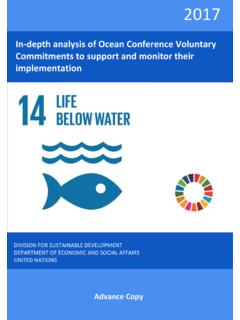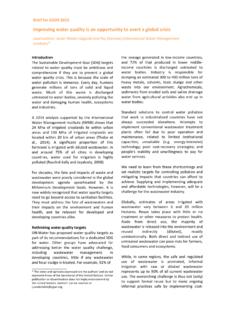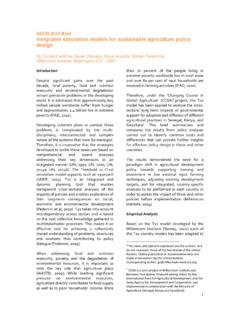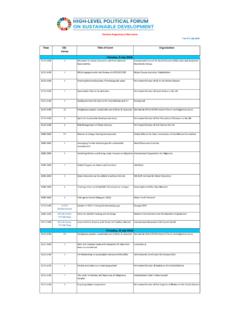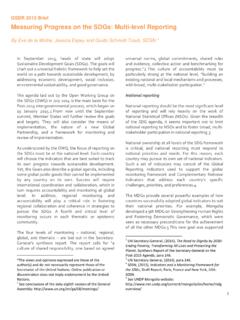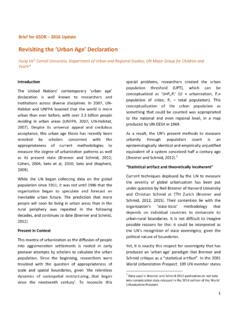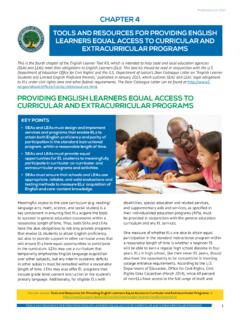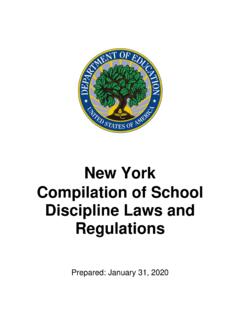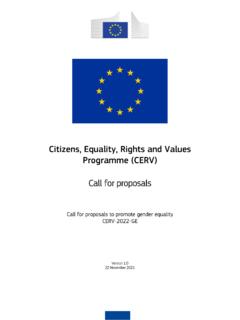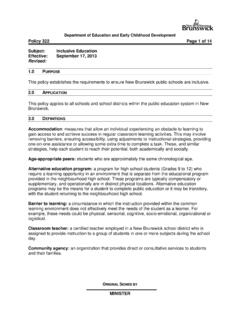Transcription of Education for Sustainable Development SOURCEBOOK
1 United Nations Educational, Scienti c and Cultural Organization Education for Sustainable Development SOURCEBOOK . Education for Sustainable Development in Action Learning & Training Tools N 4 - 2012. UNESCO Education Sector Education for Sustainable Development SOURCEBOOK . Published in 2012 by the United Nations Educational, Scienti c and Cultural Organization 7, place de Fontenoy, 75352 Paris 07 SP, France UNESCO 2012. All rights reserved ISBN 978-92-3-001063-8. The designations employed and the presentation of material throughout this publication do not imply the expression of any opinion whatsoever on the part of UNESCO concerning the legal status of any country, territory, city or area or of its authorities, or concerning the delimitation of its frontiers or boundaries. The ideas and opinions expressed in this publication are those of the authors; they are not necessarily those of UNESCO and do not commit the Organization.
2 Cover photos: 2004/P-Werquin - Agriculture 2004/P-Werquin - P cheuses Vietnam 2011/P-Werquin - Femmes Africaines Vasant Dav /Grandpa's picnic 2. Graphic design: Helmut Langer with support from Layout: UNESCO. United Nations Japan Funds-in-Trust Cultural Organization Table of Contents About this publication .. Briefs for Primary and Secondary Teachers .. What is Sustainable Development ? .. Reorienting Curriculum to Address Sustainability .. Teaching Techniques for ESD .. ESD Lesson Plans .. Assessing Pupil Learning with Rubrics .. extra - curricular Activities .. Briefs for Decision-Makers .. What is ESD? .. ESD and Adjectival Educations .. The Strengths Model .. curricular Analysis: Finding sustainability in existing curricula .. Whole-School Approach to Sustainability .. ESD Resources from UNESCO .. About this Publication The target audiences for the Education for Sustainable Development SOURCEBOOK are primary and secondary teachers and mid-level decision-makers, who have responsibility for primary and secondary Education .
3 Another primary audience is teacher educators who work with pre-service and in-service primary and secondary school teachers. The purpose of the publication is to describe ways in which Education for Sustainable Development (ESD) can be integrated into primary and secondary schooling. This collection of briefs is designed to complement other ESD. materials published by UNESCO. The topics for the briefs were selected in consultation with UNESCO Field Of ces and Institutes. The briefs for primary and secondary teachers are speci cally written for professional educators who work in formal Education settings. The briefs for teachers as well as those for decision-makers address gaps in the UNESCO ESD. literature. 2. ESD SOURCEBOOK For teachers United Nations Educational, Scienti c and Cultural Organization What is Sustainable Development ? We hold the future in our hands.
4 Together, we must ensure that our grandchildren will not have to ask why we failed to do the right thing, and let them suffer the consequences.. UN Secretary-General Ban Ki-moon, 2007. Sustainable Development is the overarching paradigm of the thought of as a long-term goal ( a more Sustainable world), United Nations. The concept of Sustainable Development while Sustainable Development refers to the many processes was described by the 1987 Bruntland Commission Report as and pathways to achieve it ( Sustainable agriculture and Development that meets the needs of the present without forestry, Sustainable production and consumption, good compromising the ability of future generations to meet their government, research and technology transfer, Education and own needs. training, etc.). Sustainability is a paradigm for thinking about a future in which environmental, social and economic considerations are balanced in the pursuit of Development and an improved Principles of Sustainable Development quality of life.
5 These three spheres society, environment All Sustainable Development programmes must consider the and economy are intertwined. For example, a prosperous three spheres of sustainability environment, society and society relies on a healthy environment to provide food and economy as well as an underlying dimension of culture. resources, safe drinking water, and clean air for its citizens. Since Sustainable Development addresses the local contexts of The sustainability paradigm is a major change from the these three spheres, it will take many forms around the world. previous paradigm of economic Development with its The ideals and principles that underlie sustainability include damaging social and environmental consequences. Until broad concepts such as equity among generations, gender recently these consequences have been seen as inevitable equity, peace, tolerance, poverty reduction, environmental and acceptable.
6 However, we now realize that major damage preservation and restoration, natural resource conservation, or serious threats to the well-being of humans and the and social justice. The Rio Declaration1 contains 27 principles, environment in pursuit of economic Development have no including: place within the sustainability paradigm. t People are entitled to a healthy and productive life in harmony with nature;. Environment Society t The right to Development must be ful lled so as to meet Environment developmental and environmental needs of present and Society future generations in an equitable way;. Economy t Eradicating poverty and reducing disparities in living Economy standards in different parts of the world are essential to Sustainable Development . t Environmental protection is an integral part of the Development process and cannot be considered in VISUALIZING SUSTAINABILITY.
7 Isolation from it. 1 The Rio Declaration emerged from the United Nations Conference on Environment and Development , also called the Earth Summit, which was We might then ask, what is the difference between Sustainable held in Rio de Janeiro in 1992. A total of 172 governments participated, Development and sustainability? Sustainability is often including 108 heads of state or government. Agenda 21 is the of cial document of the Earth Summit. 2. What is Sustainable Development ? t International actions in the elds of environment and t Seeing all humans as having universal attributes. Development should also address the interests and needs of all countries. t Knowing that technology and science alone cannot solve all of our problems. t To achieve Sustainable Development and a higher quality of life for all people, countries should reduce and eliminate t Emphasizing the role of public participation in community unsustainable patterns of production and consumption and governmental decision-making.
8 People whose lives and promote appropriate demographic policies. will be affected by decisions must be involved in the process leading to the decisions. t Women play a vital role in environmental management and Development . Their full participation is therefore t Calling for greater transparency and accountability in essential to achieving Sustainable Development . governmental decision-making. t Warfare is inherently destructive to Sustainable t Employing the precautionary principle taking action Development . Peace, Development and environmental to avoid the possibility of serious or irreversible protection are interdependent and indivisible. environmental or social harm even when scienti c knowledge is incomplete or inconclusive. These principles can guide the efforts of governments, communities and organizations to de ne sustainability goals It is important that educators, leaders, and citizens recognize and create programmes to help achieve those goals.
9 That Sustainable Development is an evolving concept and that the list of sustainability perspectives can therefore grow and change. Perspectives of Sustainable Development Not all the concepts associated with sustainability are Values within the Sustainability Paradigm incorporated in the 27 principles of Sustainable Development in the Rio Declaration. Accompanying principles of Sustainable Throughout its history, the United Nations has been a Development are perspectives that have become part of the champion of values related to human dignity, fundamental global sustainability dialogue, such as: freedoms, human rights, equity, and care for the environment. Sustainable Development takes these values a step further, t A systems thinking approach2 , rather than an approach extending them beyond the present generation to future that looks at problems in isolation should be used.
10 Generations. Sustainable Development means valuing Sustainability issues are linked and part of a whole. biodiversity and conservation along with human diversity, inclusivity, and participation . In the economic realm, some t Understanding local issues in a global context and embrace suf ciency for all while others uphold equity recognizing that solutions to local problems can have of economic opportunity. Another vehicle for the values global consequences. inherent in the sustainability paradigm is the Earth Charter, t Realizing that individual consumer decisions affect and a declaration of fundamental ethical principles for building a give rise to resource extraction and manufacturing in fair, Sustainable , and peaceful global society. distant places. t Considering differing views before reaching a decision or Sustainable Development Topics judgement. Sustainable Development includes a number of topics, t Recognizing that economic values, religious values, and which Member States have agreed to address.

